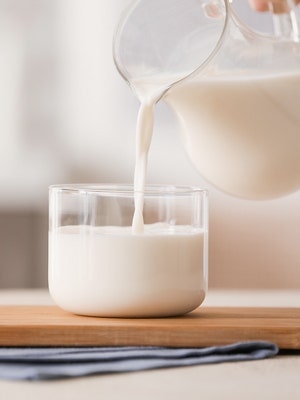Things
Glutamine is classified as non-essential amino acid since our body is able to synthesize it starting from other amino acids (arginine, ornithine and proline). However, the demonstration that glutamine concentrations decrease and its metabolism increases during pathological, catabolic or stressful states has led to reconsidering glutamine as a non-essential amino acid and to the alternative hypothesis that it can be conditionally defined as essential . In these situations, in fact, the body may not be able to cope with the high tissue demands with endogenous synthesis alone, making it necessary to introduce it from external sources.
Sources
Glutamine is mainly present in those foods that have appreciable protein shares, primarily of animal origin such as meat, fish, eggs, milk, yogurt and cheese, while among the vegetable sources we find beans, spinach, cabbage and beets.

Functions
Glutamine performs important and unique functions in the physiology landscape . It is the most abundant free amino acid in plasma and intracellular pools, it acts as a precursor for the synthesis of amino acids, Protein, nucleotides and many other biologically important molecules or for the proper performance of numerous molecular processes.
Let's see some of his roles:
Antioxidant
It participates in the formation of glutathione, the main antioxidant element available to us to counteract the excess of free radicals and oxidative stress.
Detoxifying
At the renal level, it acts as a transporter of amino groups, releasing ammonia, which is subsequently converted into ammonium ion NH4 + (highly toxic to the body) which is subsequently eliminated in the form of urea.
Acid-base balance regulator
The metabolism of glutamine in the kidneys also involves an important buffer action of the blood pH, thanks to the formation of bicarbonate, which is essential for regulating the acid-base balance.
Action in the CNS
Glutamine is able to permeate through the blood brain barrier, reaching the brain areas where it is mainly converted into glutamate, the main excitatory neurotransmitter. However, glutamate toxicity should be emphasized, so the use of glutamine must also be adequately assessed. Glutamine is also a precursor of GABA, a neurotransmitter that has inhibitory effects on nerve transmission.
Intestinal health
Glutamine is the main nutrient of enterocytes, the cells that make up the intestinal epithelium. By providing trophic support it acts as a real mucosal repair agent. By now we all know the role of an intact intestinal barrier, on which our entire state of well-being substantially depends. In fact, it is said that most of the pathologies originate at the enteric level, if this district is damaged and altered. A precarious intestinal health, in fact, characterized above all by an altered permeability opens the possibility of exposing the body to harmful substances, which trigger immune reactions, sometimes even serious. Finally, if our ability to absorb nutrients fails, all tissues are affected too,
Immune system
Not just enterocytes! It is now widely accepted that glutamine has a high turnover in immune system cells such as lymphocytes, macrophages and neutrophils. Glutamine has been reported to improve many functional parameters of immune cells such as T cell proliferation, B cell differentiation, macrophage phagocytosis, antigen presentation and cytokine production.
Muscle tissue
We must remember that about 60% 60% of glutamine present in the human body is contained in muscle tissue and its plasma concentrations decrease after intense and prolonged exercise. But what role does it play at the level of this district?
- Glycogen resynthesis: being one of the glucogenic amino acids, it is able to undertake metabolic pathways aimed at the formation of glucose when energy reserves are scarce. The gluconeogenesis process takes place mainly in the liver, which is why glutamine is also useful in the recovery phases from a workout to support the organ to restore its supplies.
- Limitation of proteolysis following exercise-induced myofibrillar damage, thanks to the ability to "sacrifice" oneself as a carbon and nitrogen donor, safeguarding other amino acids for oxidation for energy purposes.
- Cellular hydration : by favoring the entry of water, it places the cell in an optimal anabolic state, necessary for the uptake and correct use of nutrients by the muscle cell. One of the most innovative forms of glutamine for this purpose is sustamine, a dipeptide made up of glutamine and alanine.

Why integrate it
We must remember the main problem regarding this amino acid, represented by the "hunger" of the enterocytes, which in fact subtract really important percentages about the shares taken, making the fraction actually available small. An intelligent supplementation involves the consumption of a dose considered effective (up to 20-30g) to raise blood levels, generally recommended in several times of intake, especially for those critical situations for which endogenous synthesis is inadequate.
Who can benefit from it?
Glutamine is widely used in clinical practice in all those situations in which there are particularly marked organ failure that compromises its absorption and / or metabolism.

As for the world of endurance, still today there are heated debates about the real usefulness for protein synthesis or pure performance (influenced by much more "bulky" factors), while it is a good choice in athletes to improve recovery. keep the immune system alert and efficient while reducing the susceptibility to infections, typical in the case of grueling workouts without adequate rest.
BIBLIOGRAPHY
Newsholme P, Procopio J, Lima MM, Pithon-Curi TC, Curi R. Glutamine and glutamate--their central role in cell metabolism and function. Cell Biochem Funct. 2003 Mar;21(1):1-9. doi: 10.1002/cbf.1003. PMID: 12579515.
Kim MH, Kim H. The Roles of Glutamine in the Intestine and Its Implication in Intestinal Diseases. Int J Mol Sci. 2017;18(5):1051. Published 2017 May 12. doi:10.3390/ijms18051051
Wang B, Wu G, Zhou Z, Dai Z, Sun Y, Ji Y, Li W, Wang W, Liu C, Han F, Wu Z. Glutamine and intestinal barrier function. Amino Acids. 2015 Oct;47(10):2143-54. doi: 10.1007/s00726-014-1773-4. Epub 2014 Jun 26. PMID: 24965526.
Coqueiro AY, Rogero MM, Tirapegui J. Glutamine as an Anti-Fatigue Amino Acid in Sports Nutrition. Nutrients. 2019 Apr 17;11(4):863. doi: 10.3390/nu11040863. PMID: 30999561; PMCID: PMC6520936.
Antonio J, Street C. Glutamine: a potentially useful supplement for athletes. Can J Appl Physiol. 1999 Feb;24(1):1-14. doi: 10.1139/h99-001. PMID: 9916176.


Comments
Write a comment about the article